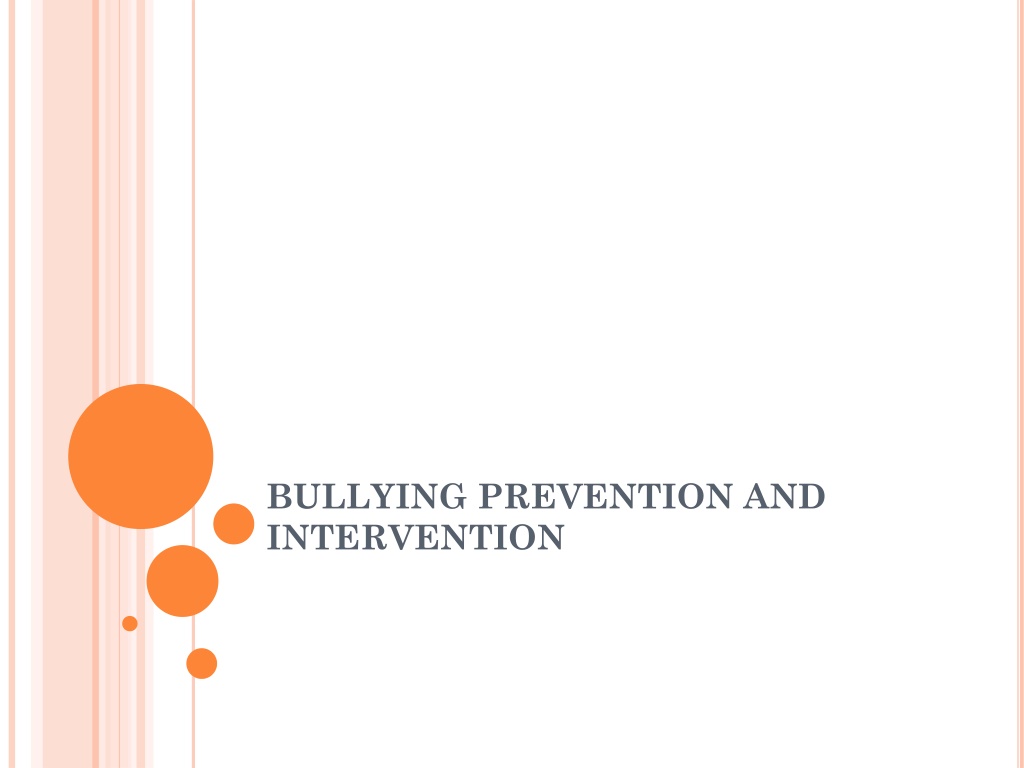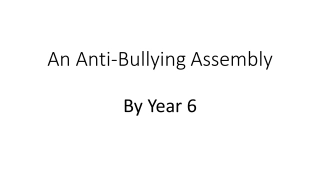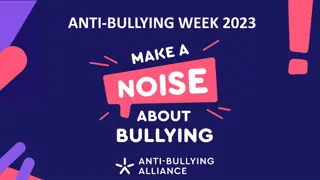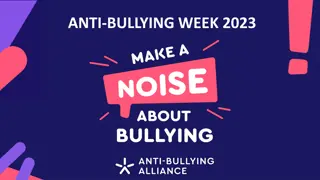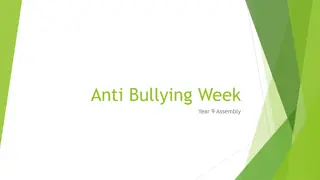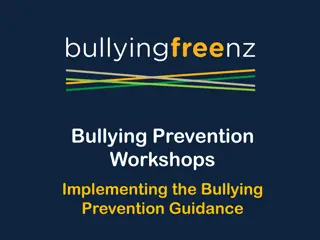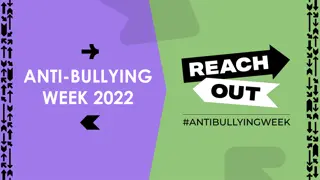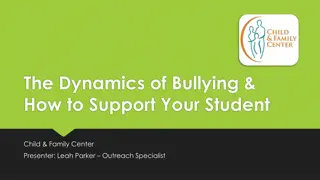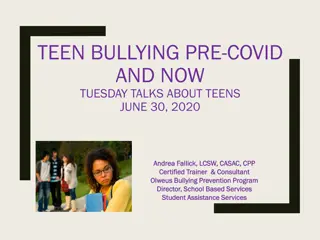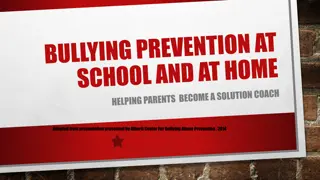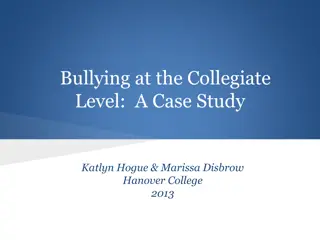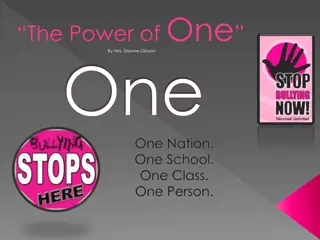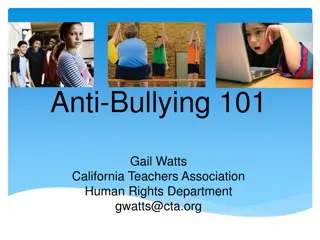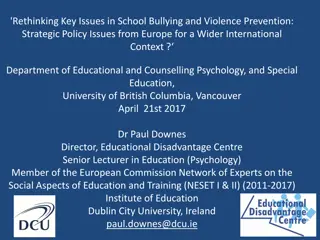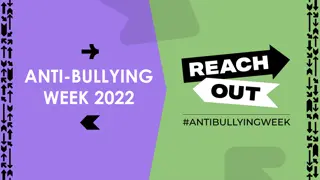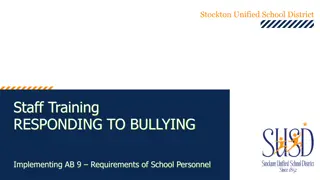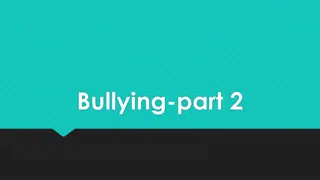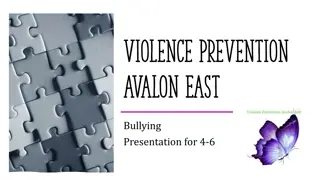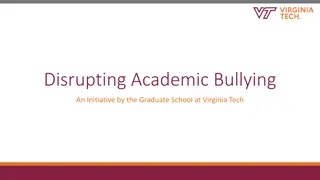Understanding Bullying: Prevention, Intervention, and Types
Delve into the comprehensive information about bullying, including its definition, prevention strategies, legal implications, and different types such as physical, verbal, social/relational, and cyberbullying. Learn about the impact of bullying on students and the importance of creating a safe and inclusive school environment.
Download Presentation

Please find below an Image/Link to download the presentation.
The content on the website is provided AS IS for your information and personal use only. It may not be sold, licensed, or shared on other websites without obtaining consent from the author. Download presentation by click this link. If you encounter any issues during the download, it is possible that the publisher has removed the file from their server.
E N D
Presentation Transcript
BULLYING PREVENTION AND INTERVENTION
According to the National Association of School Psychologists, 160,000 US students per day stay home from school because of bullying (Fried & Fried, 2003). Source: www.nea.org 2
PART 1: BULLYING OVERVIEW AND TERMINOLOGY 3
BULLYING PREVENTIONANDTHE LAW IC 20-33-8-0.2 Bullying means: Overt (intentional) unwanted, repeated acts or gestures including: Verbal or Written communication, or images transmitted in any manner (including digitally or electronically) Physical acts committed, aggression, or any other behaviors that are committed by a student or group of students against another student with the intent to Harass, ridicule, humiliate, intimidate, or harm the targeted student and Create for the targeted student an objectively hostile school environment 4
BULLYINGISDEFINEDFOR INDIANASCHOOLSIN HEA 1423 (CONT.) IC 20-33-8-0.2 (continued )- an objectively hostile learning environment : places the targeted student in reasonable fear or harm to the to the targeted student s person or property; has a substantially detrimental effect on the targeted student s physical or mental health; has the effect of substantially interfering with the targeted student s academic performance; OR has the effect of substantially interfering with the targeted student s ability to participate in or benefit from the services, activities, and privileges provided by the school
DEFINING BULLYINGIN SIMPLE TERMS Real or perceived power imbalance Unwanted, aggressive behavior 6 Repeated or potential for repeated behavior
TYPESOF BULLYING Physical Verbal Social/Relational Cyberbullying 7
PHYSICAL BULLYING Physical bullying involves hurting a person s body or possessions. Physical bullying includes: Hitting/kicking/pinching Spitting Tripping/pushing Taking or breaking someone s things Making mean or rude hand gestures 8
VERBAL BULLYING Verbal bullying saying mean things. Verbal bullying includes: Teasing Name-calling Taunting Threatening to cause harm 9
SOCIAL/RELATIONAL BULLYING Social bullying, sometimes referred to as relational bullying, involves hurting someone s reputation or relationships. Social bullying includes: Leaving someone out on purpose Telling other students not to be friends with someone Spreading rumors about someone Publically embarrassing someone 10
CYBERBULLYING Cyberbullying is bullying that takes place through the use of using various forms of electronic technology. Examples of cyberbullying include: mean text messages or emails, rumors sent by email or posted on social networking sites, and embarrassing pictures, videos, websites, or fake profiles. 11
WHATIS NOT BULLYING? There are many other types of aggressive behaviors that do not fit the definition of bullying. This does not mean that they are any less serious or do not require intervention. Peer Conflict Horseplay Hazing Fighting Stalking 12
RISK FACTORS-TARGET Perceived as being different from peers Perceived sexual orientation Perceived ability/disability level Perceived socioeconomic status Poor social skills Socially isolated/few friends Overweight/underweight 13
CHARACTERISTICS-BULLY Aggressive or easily frustrated Have less parental involvement Experiencing issues at home Think badly of others Have difficulty following rules View violence positively Lacks empathy for others 14
WARNING SIGNS STUDENT MAY BETHE TARGET Unexplainable injuries Lost or destroyed clothing, books, possessions Frequent headaches, stomach aches or illnesses Changes in eating habits Difficulty sleeping Declining grades or interest in school Not wanting to go to school Sudden loss of friends Avoidance of social situations Decreased self-esteem Self-destructive behaviors 15
EFFECTSOF BULLYING Targets of Bullying Kids who are bullied are more likely to experience: Depression and anxiety, increased feelings of sadness and loneliness, changes in sleep and eating patterns, and loss of interest in activities they used to enjoy. These issues may persist into adulthood. Health complaints Decreased academic achievement GPA and standardized test scores and school participation. They are more likely to miss, skip, or drop out of school. A very small number of bullied children might retaliate through extremely violent measures. 16 Source: www.stopbullying.gov
EFFECTSOF BULLYING (CONT.) Kids Who Exhibit Bullying Behaviors Kids who bully are more likely to: Abuse alcohol and other drugs in adolescence and as adults Get into fights, vandalize property, and drop out of school Engage in early sexual activity Have criminal convictions and traffic citations as adults Be abusive toward their boyfriend/girlfriend, spouse, or children as adults 17 Source: www.stopbullying.gov
EFFECTSOF BULLYING (CONT.) Students that Witness Bullying Incidents Witnesses are more likely to: Have increased use of tobacco, alcohol, or other drugs Have increased mental health problems, including depression and anxiety Miss or skip school 18 Source: www.stopbullying.gov
PART 2: BULLYING PREVENTION AND INTERVENTION 19
TRAINING ALL SCHOOL STAFF Bullying is everyone s problem. It will only be controlled through a total school effort. We all need to be aware of: The definitions of bullying How to recognize bullying when we see it What are our schools protocols for reporting incidents to administrators How we can contribute to creating a safe school environment 20
MARIANS POLICIESON BULLYING From the handbook: We will encourage a deeper understanding and acceptance of one another s individual gifts and unique differences. We will also work to eliminate all forms of bullying and disrespect in order to provide a truly Christ-like atmosphere in our school. Bullying, harassment, or cyberbulling (using technology to harass, humiliate, threaten, or bully another person) is considered a Level Four discipline infraction. This behavior warrants an appearance before the Marian Discipline Committee and may result in the perpetrator being suspended, asked to withdraw, or expelled. 21
HOW CAN I HELP PREVENT BULLYING AT MARIAN? Establish a school-wide culture of inclusion and respect. Use positive non-verbal interactions a smile or nod or thumbs up Notice something positive about the students and do or say something about it to them or someone else where they can hear it. Use positive terms like what to do rather than what not to do. Use positive terms like what to do rather than what not to do Maintain adequate supervision in hallways and common areas at all time Model a positive and respectful attitude when interacting with students, parents, and other faculty/staff members Be aware of Hot Spots. Bullying may be more likely to occur in areas with little or no adult supervision 22
HOW CAN I INTERVENE WHEN I OBSERVE BULLYING? Intervene immediately. It s okay to get another adult to help if necessary. Separate the students involved Stay Calm. Reassure the students involved, including witnesses. Model Respectful behavior when you intervene. Don t try to resolve the incident on the spot Don t assume that students can work it out without adult help. They can t. Report the incident to one of the administrators. Take the victim to the nurse or school counseling if necessary. Do not publically criticize the students involved 23
UPSTANDERS We all make a choice. We either decide to be a passive bystander who does nothing or an upstander who says, I will do something to help make things better. In bully-victim situations, an upstander is someone who recognizes the situation and does something to make it right. It is our responsibility to be upstanders at Marian and encourage our students to do the same. 24
